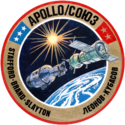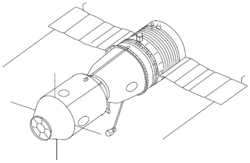Sojuz 19
| Sojuz 19 (Союз-19) | |||
 | |||
| Modell | Sojuz 7K-TM | ||
|---|---|---|---|
| Anrop | Союз (Soyuz - "Union") | ||
| Färdens tid | 5 dagar, 22 tim, 30 min, 54 sek | ||
| Massa | 6 790 kg | ||
| NSSDC-ID | 1975-065A[1] | ||
| Uppskjutning | |||
| Startplats | Bajkonur 1/5 | ||
| Start | 15 juli 1975, 12:20:00 UTC | ||
| Raket | Sojuz U | ||
| Landning | |||
| Landningsplats | 57° N 67° E | ||
| Landning | 21 juli 1975, 10:50:00 UTC | ||
| Omloppsbana | |||
| Varv | 96 st[2] | ||
| Sträcka | 3,9 miljoner km | ||
| Apogeum | 231 km | ||
| Perigeum | 218 km | ||
| Banlutning | 51,76° | ||
| Besättning | |||
| Besättning | Aleksei Leonov Valerij N. Kubasov | ||
| Dockning | |||
| Farkost | Apollo | ||
| Dockning | 17 juli 1975, 16:19:09 UTC[3] | ||
| Ur dockning | 19 juli 1975, 12:12 UTC | ||
| Andra Dockning | 19 juli 1975, 12:33 UTC | ||
| Andra ur dockning | 19 juli 1975, 15:26 UTC | ||
| Tid dockad | 1 dag, 23 tim, 7 min, 3 sek | ||
| Kronologi | |||
| |||
Sojuz 19 (ryska: Союз-19) var en flygning i det sovjetiska rymdprogrammet. Sojuz 19 ingick i Apollo-Sojuz-testprojektet och dockade med en amerikansk Apollofarkost i juli 1975. Farkosten sköts upp med en Sojuz U-raket från Kosmodromen i Bajkonur den 15 juli 1975. Man dockade med Apollo den 17 juli 1975 och tillbringade nästan två dagar tillsammans. Man lämnade Apollo den 19 juli 1975 och återinträdde i jordens atmosfär och landade i Sovjetunionen den 21 juli 1975.
Se även
Referenser
- Den här artikeln är helt eller delvis baserad på material från engelskspråkiga Wikipedia, tidigare version.
Noter
- ^ ”NASA Space Science Data Coordinated Archive” (på engelska). NASA. https://nssdc.gsfc.nasa.gov/nmc/spacecraft/display.action?id=1975-065A. Läst 28 februari 2020.
- ^ Manned Astronautics - Figures & Facts Arkiverad 8 september 2015 hämtat från the Wayback Machine., läst 8 oktober 2016.
- ^ Zarya.info Arkiverad 16 juni 2013 hämtat från the Wayback Machine., läst 30 mars 2017.
| |||||||||||||||||||
| |||||||||||||||||||||||||||||||||||||||||||||||||||||||||||||||||||||||||||||||||||||||||
| ||||||||||||||||||||||||||||||||
Media som används på denna webbplats
This is the American crew insignia of the joint United States-USSR Apollo-Soyuz Test Project (ASTP). Of circular design, the insignia has a colorful border area, outlined in red, with the names of the five crew members and the words Apollo in English and Soyuz in Russian around an artist's concept of the Apollo and Soyuz spacecraft about to dock in Earth orbit. The bright sun and the blue and white Earth are in the background. The white stars on the blue background represent American astronauts Thomas P. Stafford, commander; Vance D. Brand, command module pilot; and Donald (Deke) K. Slayton, docking module pilot. The dark gold stars on the red background represent Soviet cosmonauts Aleksey A. Leonov, commander, and Valeriy N. Kubasov, engineer.
Soyuz-A manned spacecraft concept (1963). It was to have been part of the Soyuz A-B-C circumlunar complex.
Apollo-Soyuz Test Project (ASTP) Soyuz. The APAS-75 docking unit is located at left.
Soyuz-TM spacecraft. Compare the antennas on the orbital module to those on Soyuz-T. Differences reflect the change from the Igla rendezvous system used on Soyuz-T to the Kurs rendezvous system used on Soyuz-TM.
The Soyuz TMA-04M spacecraft is seen after being rolled out by train to the launch pad at the Baikonur Cosmodrome in Kazakhstan, May 13, 2012. The launch of the Soyuz spacecraft, with Expedition 31 Soyuz Commander Gennady Padalka, Flight Engineer Sergei Revin of Russia and NASA Flight Engineer Joe Acaba, is scheduled for 9:01 a.m., May 15 (Kazakhstan time).
Författare/Upphovsman: Pascal (Flickr user: pasukaru76), Licens: CC0
Vostok spacecraft replica at the Technik Museum Speyer, Germany.













